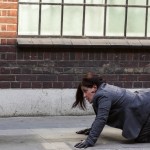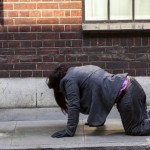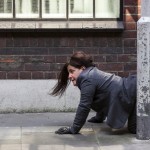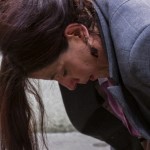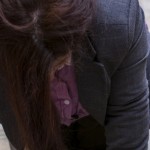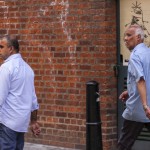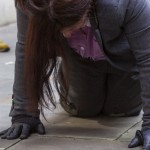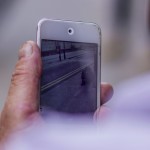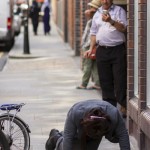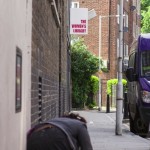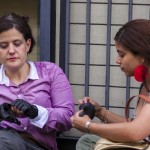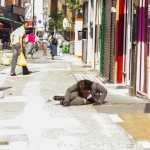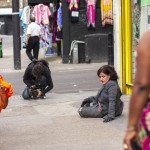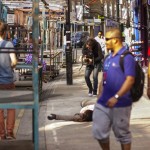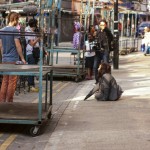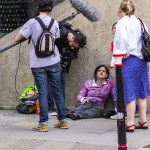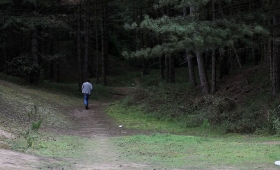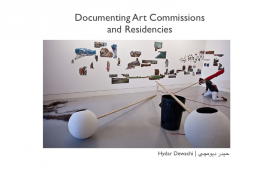On the 28th of May 2012 Noëmi Lakmaier set out from Toynbee Studios in Tower Hamlets towards the City of London, hoping to reach one one of London’s most iconic buildings the ‘Gherkin’. This normally easy 1 mile stroll was a slow and exhausting test of endurance, as she did it on her hands and knees. Smartly dressed in business attire she crawled through the everyday street life of London, her clothes getting increasingly dirty and torn. After 7 hours she crossed the border from the Borough of Tower Hamlets to the City of London.
Film by Hydar Dewachi. Sound recording by Adele Fletcher (14.40 mins)
Trailer (2.32 mins)
Selected photographs (photos by Hydar Dewachi)
Production photographs (photos by Cat Harrison)
Noëmi Lakmaier: appearance, representation and identity
By Mary Paterson
… ride up the escalator at Liverpool Street Station into a warm, dry day; watch sunlight spring in daggers from the mirrored windows of office buildings that line the road, their grand facades giving nothing away but a stream of buttoned up men and women who fill the streets with purpose, weaving through crowds of art students, creative entrepreneurs, recruitment agents, tourists, policemen who puff out their bullet proof vests and a street cleaner who wheels his cart over pavement detritus, sweeping up coffee cups and sandwich wrappers into weary piles and laughing into his hands-free-set down the line to Gambia …
In 2012 Noëmi Lakmaier performed One Morning in May, a durational work in which she attempted to crawl from Toynbee Studios, in the London Borough of Tower Hamlets, to The Gherkin, a landmark building in The City of London. The journey is only one mile long, but the effort of crawling meant that Lakmaier took over seven hours to cross the border between the two boroughs. The route took her from one of the most deprived districts in Europe to the beating heart of the (disgraced) global banking system. Dressed in smart clothes, she could have been a city worker brought to her knees, a desperate job seeker, an indebted graduate or any other version of all the people struggling, streaming and crossing paths in the centre of London. In a way, she was all of them at once.
… take a shortcut down a narrow alley lined with boutique shops and restaurants for the cash-rich-time-poor; turn your back on the ostentatious gleam of a remodelled marketplace, its geometric haircuts and statement jewellery, and head east into Petticoat Lane, a tangle of concrete side streets clattering with metal market stalls that are strung, today, with pastel rainbows of sequinned materials like Indian sweets …
‘Representation follows two laws,’ writes the performance studies academic Peggy Phelan, ‘it always conveys more than it intends, and it is never totalising.’[1] What is most striking about One Morning in May is how the ambivalence of its representation undercuts the truth-effects of the world in which it appears. This part of London is a jigsaw of contradictions: extreme wealth queuing for lunch next to extreme poverty; the international headquarters of global banks a few steps from shops advertising cheap money wires to Asia. The environment screams its presence through slogans, brand names and uniforms that each negotiates their share of space by being obviously visible. Even when something is invisible, like the goings-on behind the mirrored windows of exclusive office buildings, it is rendered obvious in a visible way.
… cross the road past a low rise estate of yellow brick houses that smells of spices and sounds of children; stop for sudden silence in the wake of an articulated lorry; move away from the learner taxi driver who putt-putt-putts his way round corners with a copy of the A to Z, take a step back, lean on a lamp post, act natural, watch the woman crawling but do not catch her eye …
Lakmaier’s presence confuses this logic. Her appearance in the streets behind Toynbee Studios is a strong visual statement; so strong that groups of people stop and stare, wavering over whether to intervene. But her visuality reveals nothing. Why is she crawling on her hands and knees on the dirty pavement? Why has she disrupted the hectic pace of the city? If she’s in need, why does she refuse a stranger’s offer of help? Unlike her surroundings, Lakmaier does not appear visually. What you see is not what you get – the crawling woman is both apparent and inexplicable to comprehend. Instead, she represents (amongst other things) visuality, and its processes.
… stab at your phone, wipe the sweat from your fingers, shade the screen from the glare of the sun, take a photograph of her crawling or not crawling but moving somehow, swinging her hips and dragging her legs behind her, hands wide, arms taught, nose close to the pavement …
If representation is her goal, the disruption of visuality is a fundamental tool in Lakmaier’s work. In 2009 she hosted a ‘dinner party for eight guests’ called We Are For You Because We Are Against Them. The guests were invited to eat dinner in front of a gallery audience, while wearing grey spheres that confined their legs and their bodies. The scene was filmed from above – an angle that accentuated the visual quality of the work over the identities of the people taking part. The dinner party was a visual spectacle in which guests were both actors and sculptures in the scene, while the audience was left to steer between different modes of looking that were hinted at in layers of display. In this way, the audience became part voyeur – watching while the hapless guests struggled to eat and talk in their ill-fitting costumes; and part gallery visitor – encouraged to appreciate the formal simplicity of the grey spheres as an art installation.
… watch a man and a woman, tall and thin as a calligraphy pen, two men with a trolley, a man with a striped suit and hair greased like Clark Gable and one man with a red handlebar moustache who leans over, self-consciously, to the crawling woman. ‘Would you like some water?’ She, brightens and smiles: ‘No, thank you!’…
In a gallery context, the formalism of the sculptural shapes resembles the formal simplicity of abstract painting or sculpture, which rose to prominence in the mid-twentieth century as the apotheosis of a modernist drive for pure form. As Rosalind Krauss has explained, the appeal of modernism was its self-contained logic: ‘it demanded that one not talk about anything in a work of art that one could not point to.’[2]
… we cross paths but we don’t communicate …
But this nod to modernism – the primacy of looking – in We Are For You … is undermined by the different types of looking on display, and the different roles available to audience and participants alike. As a collection, these competing strategies overturn the legitimacy of, for example, the flattening logic of the video angle, the messy spectacle of the embodied dinner guests, or the voyeurism of the audience. Appearances can be deceptive. The ambiguity of the title only adds to this playful confusion: We Are For You Because We Are Against Them – everyone’s allegiances are arbitrary.
… last summer a couple of miles from here, on a warm slow day just like this one, a group of hipsters was picnicking in London Fields when one of them was hit by a bullet, a shot fired from the gun of a gang member, a man of around the same age as the party, who walked the streets and rode the bus and queued at Tesco just like them but who was, until that moment, and to them, unknown …
In keeping with Phelan’s description, this excess which is also a lack – the excessive bodies that confuse the aspirations of looking – is a type of representation as opposed to identity. In We Are For You … Lakmaier uses the truth-effects of modernism as a foil to her more subtle exploration of what it means to appear in a world in relation to others. In fact, whether or not she (that is, her body) plays an explicit role, Lakmaier’s artwork is never identified with her as an individual. Instead, privacy and voyeurism, individuality and the group, seeing and being seen, are fatally combined.
… she leans on a crumbling piece of concrete next to a funeral home and a coffee shop, eats a banana, rolls a cigarette …
In Undress/ Redress (2011), Lakmaier dressed (as in One Morning in May) like a business woman as she sat in the corner of a room within a room – a compartment inside a gallery, with viewing panes carved into the sides. In the centre of her room was a table, and opposite the table another chair, with another set of identical clothes. Over the course of the day, at arbitrary times, a man entered the room, picked up Lakmaier, undressed her, redressed her in the other set of clothes, and placed her in the other chair. Here she remained until the man (Lakmaier’s collaborator in this piece, Jordan McKenzie) decided to return.
… stab at your phone; type in the hashtag #OMIM and write something, record the moment, look at an aerial view of the city …
Dressed in smart clothes inside the installation, Lakmaier looks like she has a place in the world, a job: which is to say, a way of being networked into the economic and social body. Undressed, she looks like a vulnerable young woman with no control. Importantly, however, she is never herself. Instead, the anonymity of her costume(s) along with her silence as a performer means Lakmaier represents an idea – a body, even, which appears just like her own but is not her.
‘…I am naked; feel eyes on my body; all over; uncomfortable, inquisitive stares; object of investigation; suddenly conscious of my genitals; so cold; thoughts of the warmth and sex flash through my head; push them away; stare at the light; I am object; he folds my clothes; meticulous; slow; cold; pain; light …’[3]
… she passes a wall covered in colourful graffiti: fat letters squashed in bubbles of pink and green tessellated with a so-called stranger’s illustration, an art school effort, your cynical eye predicts, but others say that it’s genuine, a code for something that happens on the street, which is to say, ‘the street’, which belongs to someone else, you notice the elegant couple has returned and the woman is taking a photograph with an old fashioned camera, the type that takes film …
It is tempting to draw comparisons between this type of work and performance art of the 1960s and 70s that sought to investigate women’s role in the world. In Rhythm 0 (1974), for example, Marina Abramovic stood on a plinth and invited audience members to use various tools on her body. She provided 72 tools, including a gun. ‘I felt really violated,’ Abramovic has said:
‘they cut up my clothes, stuck rose thorns in my stomach, one person aimed the gun at my head, and another took it away. It created an aggressive atmosphere. After exactly 6 hours, as planned, I stood up and started walking toward the audience. Everyone ran away, to escape an actual confrontation.’[4]
… your senses enveloped by traffic, the heaving pulse of the road your soundtrack and you couldn’t talk to her now even if you wanted to, even if it was appropriate, in a public place, to impose yourself on a woman doing something so unwilling to be explained …
Abramovic’s act was symbolic, but it was also deeply personal. She appeared in Rhythm O as a woman, but more importantly as Marina Abramovic, using herself in an experiment for which she could not predict the outcome. While her body may have represented the social body and her experiment reached for life and death[5], the life at stake was singularly Abramovic’s life; the death, Abramovic’s death.
… two people have stopped, independent of one another, limbs still, eyes unblinking; one of them holds a rucksack at a distance from his body like a weapon …
In contrast, Lakmaier does not occupy a stable identity within her work. Instead, she repeatedly hints at more and other ways of seeing or comprehending her and others’ bodies. Just as in We Are For You …, Undress/ Redress contains a deferred layer of looking: CCTV cameras that stream live footage of the performance to the front door of the gallery. Meanwhile, parallel viewing panes frame other members of the audience as much as they focus attention on Lakmaier and McKenzie inside the room. This means that viewers do not have a stable identity in Lakmaier’s work either. Being watched here and elsewhere, we are drawn into the performance: our looking a type of taking part. In fact, everybody here – viewers, performers, voyeurs, actors – appears and disappears in relation to all these different views.
… stop at a distance, independent of them, watch the shadow you cast on the burning pavement, the three of you, netted together in this public place while the business woman goes about her business, crawling and heaving her body along the street, nose close to the gutter, eyes screwed with the effort …
Perhaps this flux is why Lakmaier does not feel threatened by her audience. While Abramovic says, ‘I felt violated’, Lakmaier says, ‘I am object.’ The younger artist embraces her object-hood as a role to be played in the relations of looking.
Of course, a more predictable interpretation of Lakmaier’s description of this performance might be that she has internalised the panoptical male gaze that subjects all female bodies, in order to anticipate the objectifying judgment that she – as a disabled woman – must come to expect[6]. While this may be true to an extent, this judgment is more usefully seen as the foil to Lakmaier’s explorations of representation – like the truth-effects of the streets of London in One Morning in May, or the primacy of looking in modernism in We Are For You Because We Are Against Them. Like these other foils, the omnipresent male gaze is a type of visual domination. And, like these other foils, it is subtly undermined by a series of shifting perspectives.
In fact, any internalisation in Lakmaier’s work does not relate to the performance of personal identity so much as the durational processes in which identity is perceived: she may not represent an identity, but she does come to stand for representation itself. As a result, and paradoxically, Lakmaier’s work both eschews the limits of identity and demands a personal interaction with each member of the audience.
… the hoardings outside Whitechapel Gallery advertise the unveiling of a new work of art, shielding the work that cannot be seen, announcing the invisible; here, where the pavement narrows, there is a bottleneck of pedestrians …
The cultural philosopher Brian Massumi describes perception as an active relation that ‘lies between perceiver and perceived.’[7] To perceive, he says, is to participate in an act of selection derived from all that you know and all that you believe is possible. Massumi’s understanding of perception means that the body perceiving and the object being perceived act on each other, in order to transform each other’s world view. ‘Body’ and ‘object’, he writes, ‘are differential plug-ins into the same forces, two poles of the same connectability.’[8]
… you are at the back of the queue; a man with a plastic bag waits his turn then stops, starts, stumbles at the sight of the woman crawling along the street; young people walk past then step back, laugh and grin at each other as if to say, to anyone looking, that they are in on the joke …
It is this act of perception, rather than simply looking, to which Lakmaier’s work aspires. She creates spaces for representation, as opposed to identity, that keep perception active by providing an oscillating range of interpretations, both for now (the place of performance, which includes the static viewing modes suggested in each piece) and in the future (their simultaneous documents as photography or film).
… stab at your phone, consult a map, Twitter, make your way to a back street where the sun is so strong the tarmac could be melting …
‘Human perception,’ writes Massumi, ‘is unique in the degree to which it can extend itself into the only-thought and, thus, into the future in more and more varied ways.’[9] The only-thought is the object in general, understood before its potential has been reduced (‘selected’) by the pre-conceived ideas of the perceiver. In this context, the object that Lakmaier becomes inside Undress/ Redress is an only-thought that increases the complexity of the audience’s perception of the work of art. It sustains the potential of the performance and keeps its questions open: is she alright? is she being held captive? is this her job? is she in control?
… at the crossroads, the crawling woman rolls, she rolls across the road in front of waiting cars and her jacket flings open as she lies on her back, momentarily, then flips back again as she plunges her head to the pavement and rolls towards the dip in the kerb on the other side of the street where she stops, waiting, panting, on her hands and knees, as soon as she finds a scrap of shade to roll into …
It’s important to note that Massumi’s description of perception occurs alongside his interpretation of the work of Australian artist Stelarc, whom Massumi argues can invent ideas inside the body: ‘it was only after the manifestation of the ideas [in Stelarc’s work] began in the body that they were able to be disengaged enough from it in order to enter speech and writing.’[10] As a woman, Lakmaier does not have that luxury: a woman’s body is already written and discursive – already rendered visible.
… doll, toy, artist, student, city worker brought to her knees, foreigner, native, rich, poor, destitute, shameful, someone like you, someone like me, neither of us, playing, controlling, abused, cared for, lonely, accompanied, watched, seen, remembered, unknown, here, invisible, there…
But Lakmaier refuses to identify as an individual woman, or even a symbolic woman. If anything she’s a floating woman, like a floating signifier. The bodies in her work – her own or other people’s – are always in costume and always in character: a business woman, a sculptural object, a nude. This does not stop them expanding into the only-thought of other identities. In fact, it enables it. Tethered to no identity, the bodies in Lakmaier’s work are in the eyes of the perceiver. To be an audience member – voyeur, visitor or participant – is to witness your own act of perception in the duration of the encounter.
… take a shortcut through a car park to avoid being seen. By whom? By anyone who might wonder at your purpose, who might implicate you in the inexplicable case of the crawling woman who crawls and heaves her body along the street while the pollution sweats down her face like tears …
On one level this desire to go beyond a single embodied experience does, after all, have a link to radical body art of the twentieth century. The art historian Maaike Bleeker takes issue with dominant understandings of body art as a practice of identity, and suggests instead that it reaches for transcendence – an impossible dream, which is also a function of the knowledge it can never be attained. Looking at transgressive (male) performance art of the 60s and 70s, Bleeker asks,
‘Is subversion … a means of criticising the particular consequences of modernism and global capitalism, or is the subversion of modernism and global capitalism (also) a means of reaching some kind of (imagined) ‘existential beyond’? A beyond that rather than confirming the body as the site of self involves a certain alienation from the body by means of a transgression of its limits, as well as a transgression of the ways in which the body limits our existence to a particular moment in time and space?’[11]
… wait here; watch and wait …
Perhaps there was a grain of truth in the subverted aesthetic purity of We Are For You Because We Are Against Them. Is Lakmaier aiming at a kind of transcendence after all? Are the different layers of mediation in her work not only a means of complicating the gaze but also of escaping the hegemony of appearance itself: a way of extending (her) existence into another realm?
… the screen flashes, #OMIM, the screen is the woman, but she is not there; send a message, take a photograph, record your movements, let others know, her clothes are torn, her body is wet, her limbs are shaking …
As she reached the end of One Morning in May, Lakmaier’s exhausted body might have represented work, money, global capital, women, poverty, madness or the other. As an artist, she stands for the ways these ideas are represented and mediated through images, discourse and time. Her work disrupted the busy flow of a corner of London and the logic of visual truth-effects it endlessly performs; and this disruption stems not just from the slow progress of her body but also form her insistence that perception is a relationship activated by the body that is seen as well as the body that is looking.
… you have been walking for hours in this heat, in this pulsing sun, in this slow stretch of a day; walk back into the city; become one of the people moving, streaming, filling the streets with purpose …
After a gruelling day’s work, Lakmaier crawls over the border to the City of London but does not reach her goal, The Gherkin. In a sense, it does not matter. The aspiration is still there: the aspiration to reach beyond the limits of a body (Lakmaier’s body, or the body of any single onlooker), and all that it represents. In Massumi’s terms, Lakmaier has increased the potential of what is possible. While the action is unfinished, the perceptual act is still alive.
[1] Peggy Phelan Unmarked: The Politics of Performance (Routledge), p. 2
[2] Rosalind Krauss ‘A View of Modernism’ pp. 953-956 in C Harrison and P Word eds Art In Theory 1900 – 1990 (Blackwell, 1990), p. 955
[3] Noëmi Lakmaier ‘Undress/ Redress (After)’ pp. 108-9 in Access All Areas (Live Art Development Agency, 2012), p, 109
[4] Quoted in eds. M Abramovic, A Danieri, G Di Pietrantonio, L Heygi, Societas Rafaello Sanzio, A Vettesse (Charta, 2002) Marina Abramovic , p. 29
[5] Phelan, ‘On Seeing the Invisible’ pp. 16 – 27 in A Heathfield ed. Live (Tate, 2004) passim
[6] See, for instance, John Berger Ways of Seeing (Penguin, 1972)
[7] Brian Massumi Parables for the Virtual (Duke University Press, 2002), p. 90
[8] Ibid., p. 95
[9] Ibid., p. 93
[10] Massumi, ibid., p. 89
[11] Maaike Bleeker ‘Make the most of now: radical mayflies, and the dear of representation.; pp. 27 – 50 in M Schavemaker and M Rakier, eds. Right About Now (Colophon, 2007) p. 34
‘One Morning in May’ was supported by an Artsadmin Bursary 2010-2011

